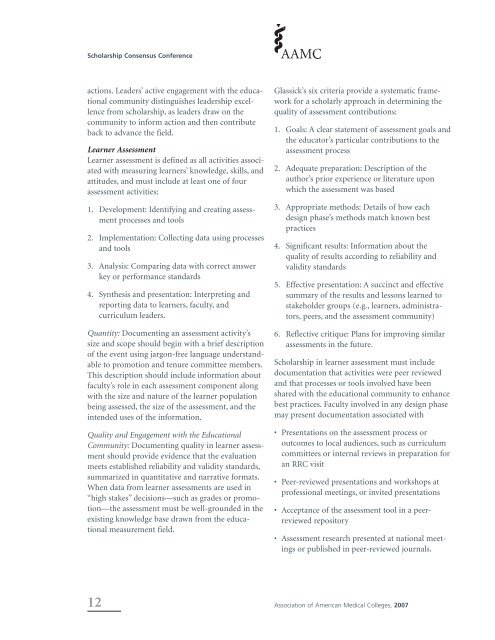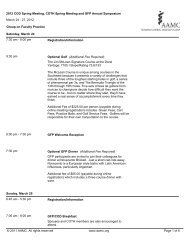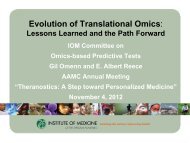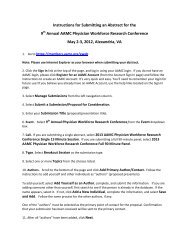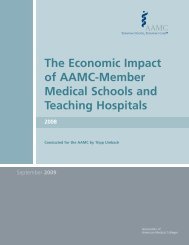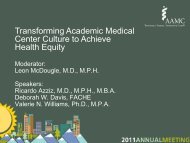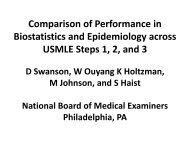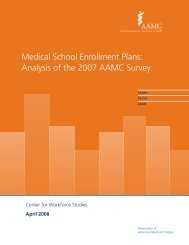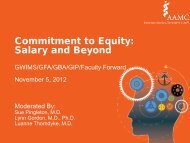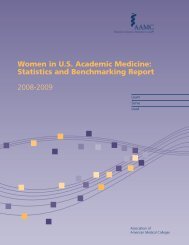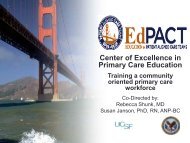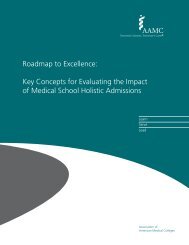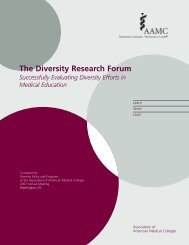Advancing Educators and Education - AAMC's member profile
Advancing Educators and Education - AAMC's member profile
Advancing Educators and Education - AAMC's member profile
Create successful ePaper yourself
Turn your PDF publications into a flip-book with our unique Google optimized e-Paper software.
Scholarship Consensus Conferenceactions. Leaders’ active engagement with the educationalcommunity distinguishes leadership excellencefrom scholarship, as leaders draw on thecommunity to inform action <strong>and</strong> then contributeback to advance the field.Learner AssessmentLearner assessment is defined as all activities associatedwith measuring learners’ knowledge, skills, <strong>and</strong>attitudes, <strong>and</strong> must include at least one of fourassessment activities:1. Development: Identifying <strong>and</strong> creating assessmentprocesses <strong>and</strong> tools2. Implementation: Collecting data using processes<strong>and</strong> tools3. Analysis: Comparing data with correct answerkey or performance st<strong>and</strong>ards4. Synthesis <strong>and</strong> presentation: Interpreting <strong>and</strong>reporting data to learners, faculty, <strong>and</strong>curriculum leaders.Quantity: Documenting an assessment activity’ssize <strong>and</strong> scope should begin with a brief descriptionof the event using jargon-free language underst<strong>and</strong>ableto promotion <strong>and</strong> tenure committee <strong>member</strong>s.This description should include information aboutfaculty’s role in each assessment component alongwith the size <strong>and</strong> nature of the learner populationbeing assessed, the size of the assessment, <strong>and</strong> theintended uses of the information.Quality <strong>and</strong> Engagement with the <strong>Education</strong>alCommunity: Documenting quality in learner assessmentshould provide evidence that the evaluationmeets established reliability <strong>and</strong> validity st<strong>and</strong>ards,summarized in quantitative <strong>and</strong> narrative formats.When data from learner assessments are used in“high stakes” decisions—such as grades or promotion—theassessment must be well-grounded in theexisting knowledge base drawn from the educationalmeasurement field.Glassick’s six criteria provide a systematic frameworkfor a scholarly approach in determining thequality of assessment contributions:1. Goals: A clear statement of assessment goals <strong>and</strong>the educator’s particular contributions to theassessment process2. Adequate preparation: Description of theauthor’s prior experience or literature uponwhich the assessment was based3. Appropriate methods: Details of how eachdesign phase’s methods match known bestpractices4. Significant results: Information about thequality of results according to reliability <strong>and</strong>validity st<strong>and</strong>ards5. Effective presentation: A succinct <strong>and</strong> effectivesummary of the results <strong>and</strong> lessons learned tostakeholder groups (e.g., learners, administrators,peers, <strong>and</strong> the assessment community)6. Reflective critique: Plans for improving similarassessments in the future.Scholarship in learner assessment must includedocumentation that activities were peer reviewed<strong>and</strong> that processes or tools involved have beenshared with the educational community to enhancebest practices. Faculty involved in any design phasemay present documentation associated with• Presentations on the assessment process oroutcomes to local audiences, such as curriculumcommittees or internal reviews in preparation foran RRC visit• Peer-reviewed presentations <strong>and</strong> workshops atprofessional meetings, or invited presentations• Acceptance of the assessment tool in a peerreviewedrepository• Assessment research presented at national meetingsor published in peer-reviewed journals.12Association of American Medical Colleges, 2007


